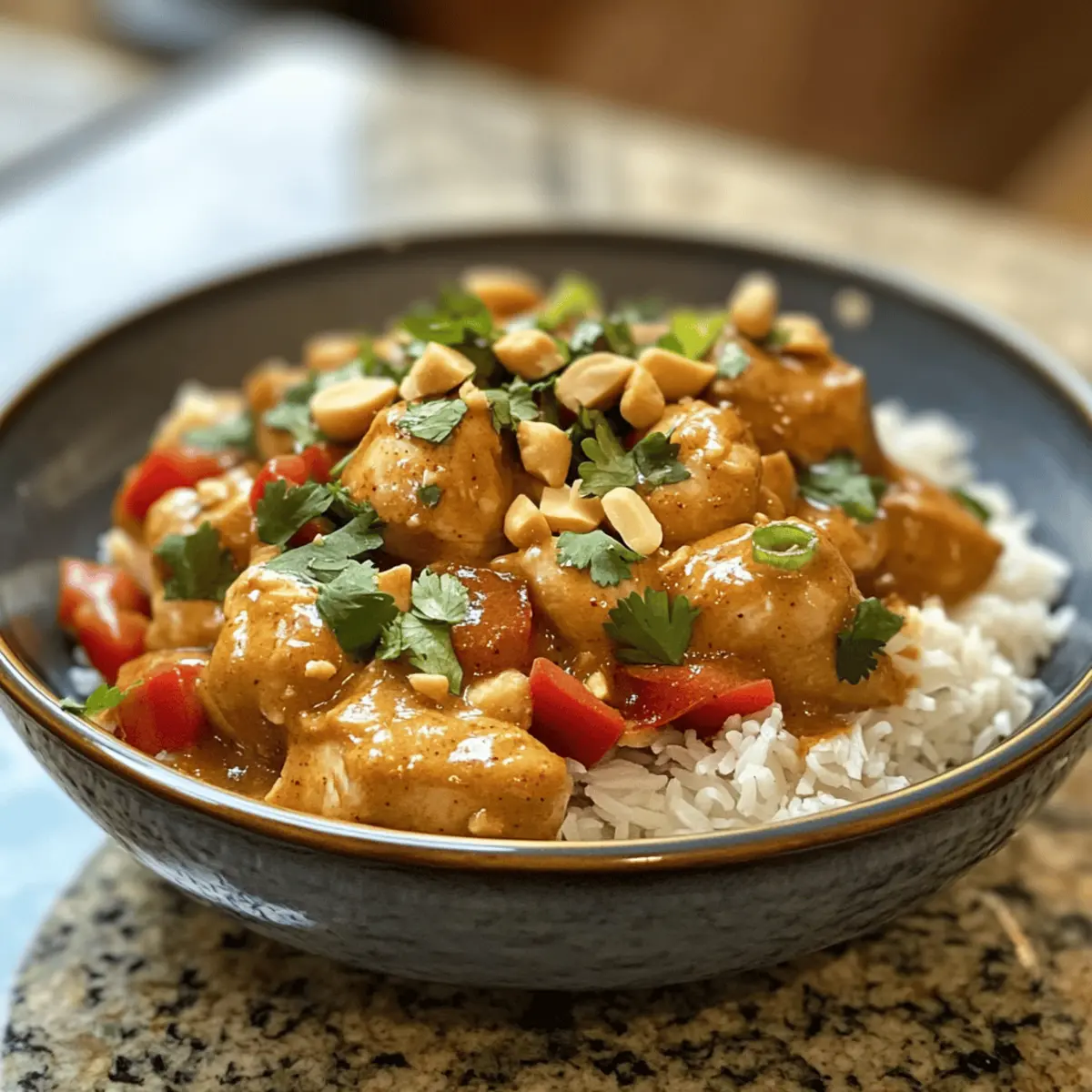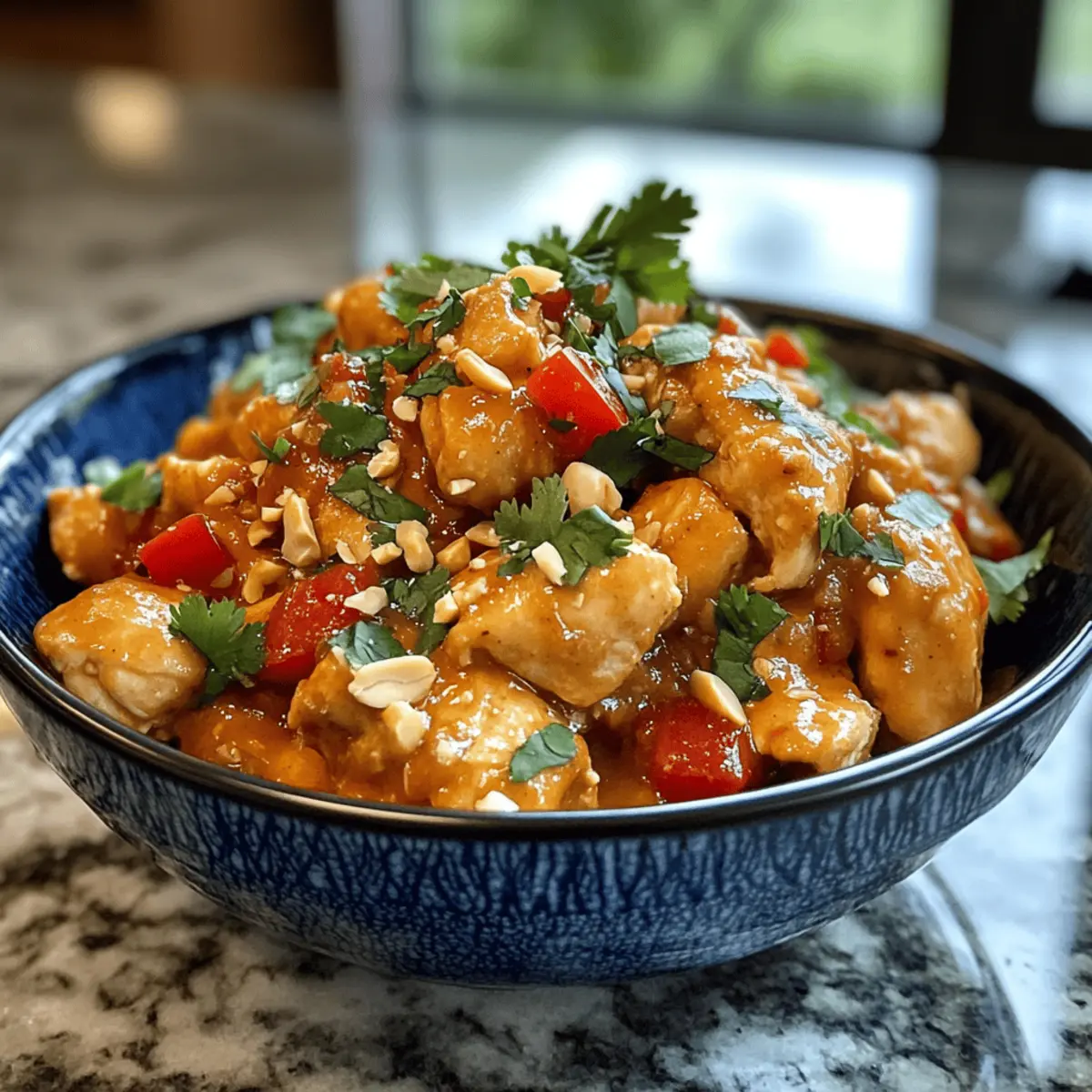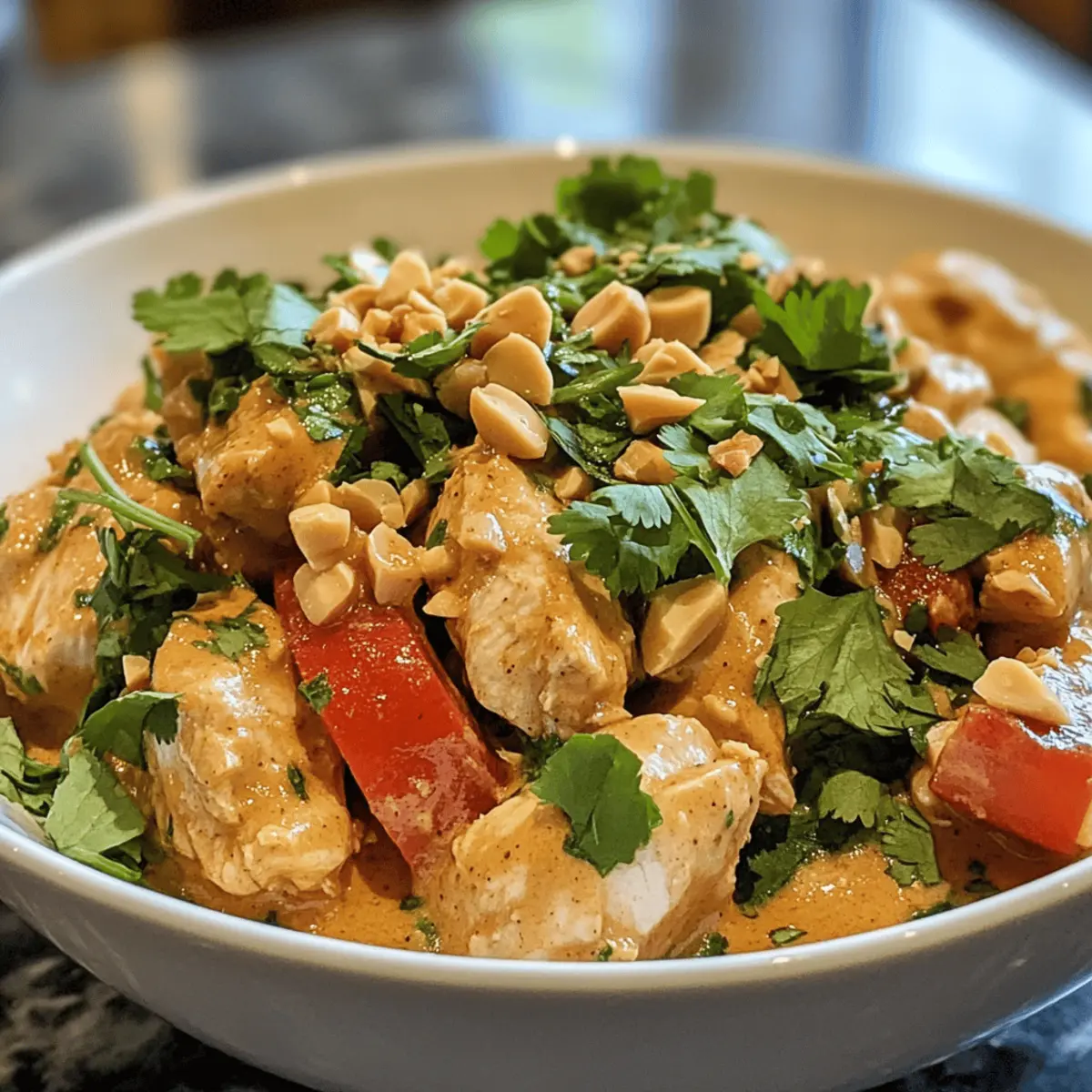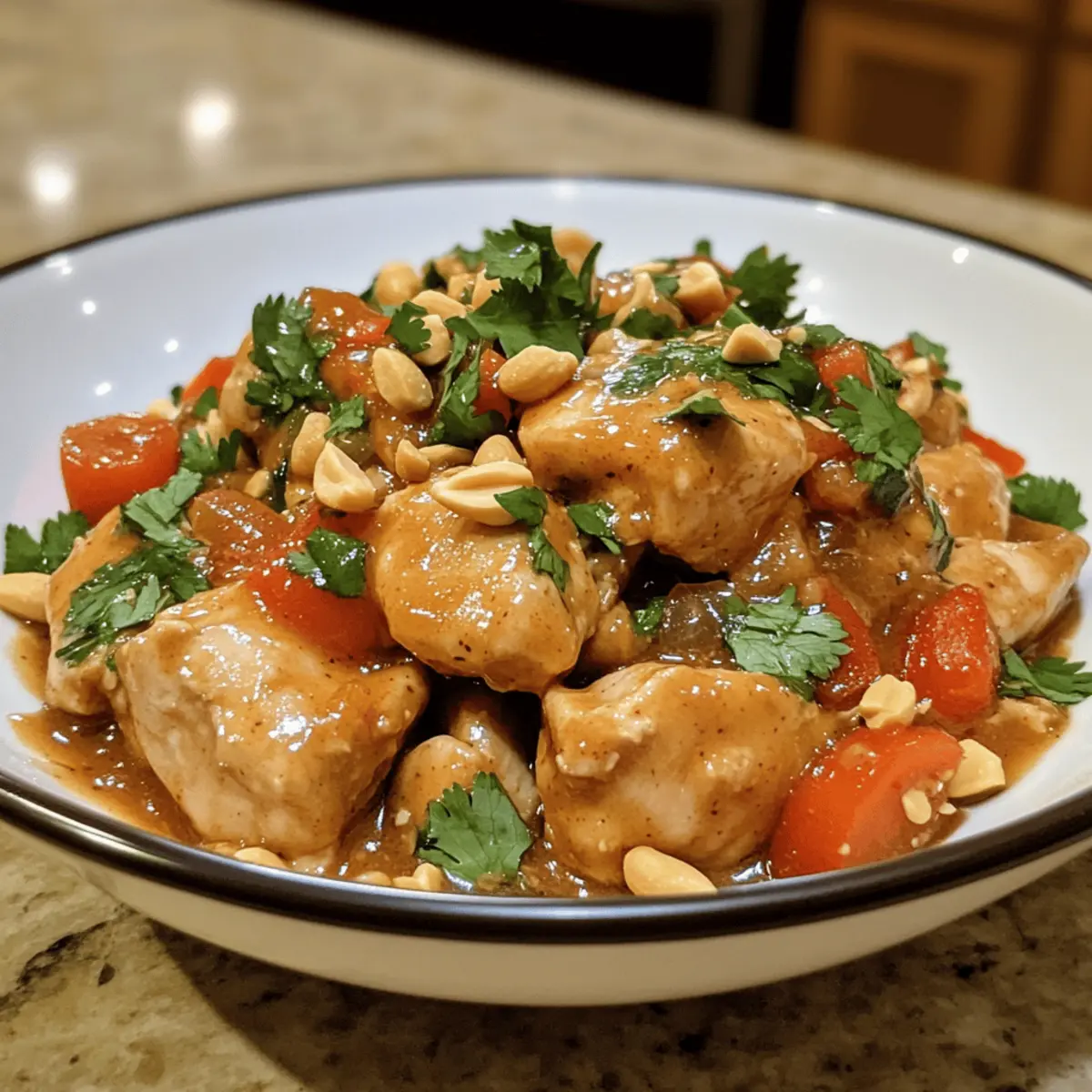There’s nothing quite like the rush of creating a mouthwatering dish in under 30 minutes. If you’re craving something delightful yet simple, let me introduce you to my Quick Thai Peanut Chicken. This recipe masterfully combines juicy chicken pieces with a creamy peanut sauce that dances between savory, nutty, and just the right touch of sweetness. Not only is it perfect for busy weeknights, but it also impresses guests when you’re entertaining. Plus, it’s versatile enough to adapt for vegetarians—simply swap in tofu or tempeh! Ready to transform your dinner routine with a splash of Thai flavor? Let’s dive into this irresistible recipe!

Why is Thai Peanut Chicken a must-try?
Quick and Easy: This recipe takes less than 30 minutes, making it a perfect solution for busy weeknights.
Flavor Explosion: The creamy peanut sauce elevates the dish with rich, umami flavors, satisfying even the pickiest eaters.
Versatile Option: Easily adaptable for the whole family—just swap chicken for tofu or tempeh for a delicious vegetarian meal!
Crowd-Pleaser: Impress your guests with a dish that feels gourmet yet is incredibly simple to prepare. Feel free to add vibrant vegetables, like bell peppers or snow peas, for a nutritious twist! If you enjoy quick recipes, check out my Thai Peanut Chicken for more delicious options.
Thai Peanut Chicken Ingredients
• Dive into the flavors with these essential ingredients for your Thai Peanut Chicken!
For the Chicken
- Boneless Chicken Breasts – This is your primary protein source; consider using thigh pieces for even juicier results.
For the Peanut Sauce
- Peanut Butter – It provides a creamy richness and deep flavor; choose natural varieties without additives for the best taste.
- Soy Sauce – Adds an umami punch; substitute with tamari for a gluten-free option.
- Coconut Milk – This gives the sauce its creaminess; for a lighter alternative, swap in heavy cream or almond milk.
- Garlic – Enhances flavor and aroma; freshly minced garlic is preferred over powdered forms for a fresher taste.
- Fresh Lime Juice – Offers acidity and brightness; for optimal flavor, always use fresh lime instead of bottled juice.
For the Veggies
- Vegetables (e.g., bell peppers, carrots) – Adds vibrant color and texture; feel free to use any seasonal veggies you have on hand for freshness.
For Cooking
- Cooking Oil – Necessary for sautéing; any high smoke point oil like canola or vegetable oil will work perfectly.
Now you’re all set to cook up a storm with this delicious Thai Peanut Chicken!
Step‑by‑Step Instructions for Thai Peanut Chicken
Step 1: Prepare the Chicken
Begin by cutting the boneless chicken breasts into bite-sized pieces and seasoning them generously with salt and pepper. This will enhance the flavor of the Thai Peanut Chicken. Make sure the pieces are uniform for even cooking. Set them aside while you heat your skillet, preparing for the next step.
Step 2: Cook the Chicken
In a large skillet, heat 2 tablespoons of cooking oil over medium-high heat until shimmering. Carefully add the seasoned chicken pieces to the skillet in a single layer, cooking them undisturbed for about 5-7 minutes. Stir occasionally until they are golden brown and no longer pink in the center. Remove the cooked chicken from the skillet and set aside.
Step 3: Make the Sauce
Lower the heat to medium and in the same skillet, add the minced garlic, sautéing for about 1 minute until fragrant. Stir in the soy sauce, peanut butter, and coconut milk, blending well to create a creamy sauce. Allow the mixture to simmer gently for 2-3 minutes, making sure it doesn’t boil too violently to maintain that rich consistency.
Step 4: Combine Ingredients
Return the cooked chicken to the skillet with the peanut sauce, stirring well to coat all the pieces evenly. Let it simmer for an additional 3-4 minutes, ensuring everything is heated through and the chicken is well-coated with that luscious Thai Peanut Chicken sauce. The sauce should thicken slightly as it mingles with the chicken.
Step 5: Serve
Once everything is heated and combined to perfection, remove the skillet from heat. Plate the Thai Peanut Chicken and garnish with chopped peanuts or fresh cilantro for an added crunch and color. Serve this delicious dish hot over steamed jasmine rice or rice noodles for a truly satisfying meal.

How to Store and Freeze Thai Peanut Chicken
Fridge: Store any leftovers in an airtight container for up to 3 days to maintain freshness and flavor.
Freezer: Freeze the Thai Peanut Chicken in a sealed container for up to 3 months. For best results, portion it out into meal-size servings.
Reheating: When you’re ready to enjoy it again, thaw overnight in the fridge, then reheat gently on the stovetop over low heat, adding a splash of coconut milk or water to restore creaminess.
Room Temperature: Avoid leaving Thai Peanut Chicken out at room temperature for more than 2 hours to ensure food safety.
Tips for the Best Thai Peanut Chicken
• Fresh Ingredients: Always use fresh garlic and lime juice for a vibrant flavor. Bottled alternatives can dull the essence of your Thai Peanut Chicken.
• Don’t Overcook: Keep an eye on the chicken; overcooking can make it dry. Aim for a golden color and an internal temperature of 165°F (75°C).
• Sauce Balance: If the sauce is too salty, a pinch of sugar can counteract it. Adjust until you reach that perfect savory-sweet balance for the Thai Peanut Chicken.
• Vegetarian Friendly: Substitute chicken with tofu or tempeh for a delightful vegetarian option that doesn’t sacrifice flavor.
• Sautéing Tips: Use a high smoke point oil for frying the chicken—this helps achieve that golden brown crust while preventing burning.
• Garnish for Flair: Top with chopped peanuts or fresh cilantro right before serving to enhance the dish’s visual appeal and add a satisfying crunch!
Thai Peanut Chicken Variations & Substitutions
Customize your Thai Peanut Chicken and create something uniquely delicious—let your imagination run wild, and savor the results!
-
Vegetarian Swap: Replace chicken with tofu or tempeh, marinating beforehand for extra flavor. This swap retains creaminess and adds a delectable texture.
-
Extra Veggies: Toss in vibrant vegetables like broccoli, snap peas, or zucchini to enhance nutrition and color. The crunch from fresh veggies elevates the dish beautifully!
-
Noodle Twist: Serve over rice noodles instead of jasmine rice for a fun and chewy texture. The sauce clings perfectly to noodles for a satisfying meal.
-
Nut-Free Option: Use sunbutter or a seed butter instead of peanut butter for a nut-free version. This will give you that creamy consistency while keeping it allergen-friendly.
-
Heat it Up: For a spicy kick, add red pepper flakes or a dash of sriracha to the sauce. You can control the heat level to suit everyone’s taste!
-
Grilled Flavor: Marinate the chicken in the sauce before grilling for a smoky twist. This method imparts a charred flavor that adds depth to your Thai Peanut Chicken.
-
Coconut Substitute: If you want a lighter alternative, replace coconut milk with almond milk or yogurt. This will change the flavor profile slightly but still keep it creamy.
If you’re looking for even more delicious ideas, why not check out my Cheesy Chicken Spaghetti or try my Cowboy Butter Chicken? They’ll inspire you to keep the fun rolling in the kitchen!
What to Serve with Thai Peanut Chicken
When it comes to creating a delightful meal around Thai Peanut Chicken, you want delightful companions that enhance its rich flavors.
-
Steamed Jasmine Rice: This fragrant rice absorbs the creamy sauce beautifully, making each bite a gentle, comforting experience.
-
Crispy Thai Slaw: A crunchy blend of cabbage, carrots, and a zesty dressing adds freshness and texture, perfectly balancing the richness of the sauce.
-
Grilled Corn on the Cob: Sweet and smoky, grilled corn creates a delightful contrast to the savory notes of the dish, making it a seasonal favorite.
-
Fresh Cucumber Salad: The cool and crisp cucumbers tossed in a light vinaigrette cleanse the palate, offering a refreshing bite to complement the savory chicken.
-
Peanut-Sesame Noodles: The nuttiness ties the meal together, offering a delightful flavor profile that mirrors the peanut sauce in the main dish.
-
Thai Iced Tea: A sweet, creamy beverage that contrasts the spicy notes of Thai cuisine while providing a luxurious touch to your meal.
-
Mango Sticky Rice: For dessert, this traditional Thai treat brings a sweet finish, balancing the meal with its luscious coconut flavors and sticky texture.
-
Lime Sparkling Water: Light, fizzy, and refreshing, this drink complements the citrusy notes of the dish while enhancing the overall dining experience.
Make Ahead Options
These Quick Thai Peanut Chicken options are perfect for busy home cooks looking to save time during the week! You can prepare the chicken and vegetables (like bell peppers and carrots) up to 24 hours in advance. Simply cut the chicken into bite-sized pieces, season, and store it in an airtight container in the refrigerator. The sauce can also be made ahead by combining the peanut butter, soy sauce, coconut milk, and garlic, which will maintain its delicious flavor for up to 3 days when refrigerated. When you’re ready to serve, just cook the chicken, heat the sauce, and combine them for a meal that’s just as delectable as if made fresh!

Thai Peanut Chicken Recipe FAQs
What should I look for when selecting chicken?
When choosing chicken, look for boneless chicken breasts that are firm and pink, with no dark spots or excessive liquid packaging. If you’re after juicier meat, consider opting for boneless chicken thighs. They often have great flavor and tenderness.
How long can I store leftover Thai Peanut Chicken?
You can store any leftover Thai Peanut Chicken in an airtight container in the fridge for up to 3 days. For best taste and texture, consume it within this timeframe. Be sure to reheat it gently in the microwave or skillet to retain that creamy sauce!
Can I freeze Thai Peanut Chicken? How?
Absolutely! To freeze Thai Peanut Chicken, portion it into meal-sized servings and place in airtight containers or freezer bags. It will keep well for up to 3 months. When ready to enjoy, thaw it overnight in the fridge and reheat on low heat, adding a splash of coconut milk to restore creaminess.
What should I do if my sauce is too thick or too salty?
If your peanut sauce gets too thick, simply stir in a small amount of coconut milk or water to reach the desired consistency. For a salty sauce, add a pinch of sugar to balance it out. Adjust ingredients gradually, tasting as you go to achieve that perfect savory-sweet harmony.
Is this recipe safe for people with peanut allergies?
Unfortunately, this recipe contains peanut butter, making it unsuitable for individuals with peanut allergies. However, you can try substituting the peanut butter with sunflower seed butter or almond butter if allergies permit, keeping in mind that it will alter the flavor slightly.
Can I use other vegetables? What’s best?
Yes! The beauty of Thai Peanut Chicken is its versatility. Feel free to incorporate seasonal vegetables like broccoli, snap peas, or carrots. Just chop them into similar sizes for even cooking, adding them to the skillet with the sauce for a few extra minutes until tender-crisp.

Savory Thai Peanut Chicken in Under 30 Minutes
Ingredients
Equipment
Method
- Begin by cutting the boneless chicken breasts into bite-sized pieces and seasoning them generously with salt and pepper. Set aside.
- In a large skillet, heat cooking oil over medium-high heat. Add the seasoned chicken pieces and cook undisturbed for about 5-7 minutes, stirring occasionally until golden brown and cooked through.
- Lower the heat and add minced garlic to the skillet, sautéing for about 1 minute. Stir in soy sauce, peanut butter, and coconut milk, blending well to create a creamy sauce. Simmer gently for 2-3 minutes.
- Return the cooked chicken to the skillet with the peanut sauce, stirring well to coat all pieces evenly. Let it simmer for an additional 3-4 minutes.
- Once everything is heated, remove from heat, plate the Thai Peanut Chicken, and garnish with chopped peanuts or fresh cilantro. Serve hot over steamed Jasmine rice or rice noodles.

Leave a Reply